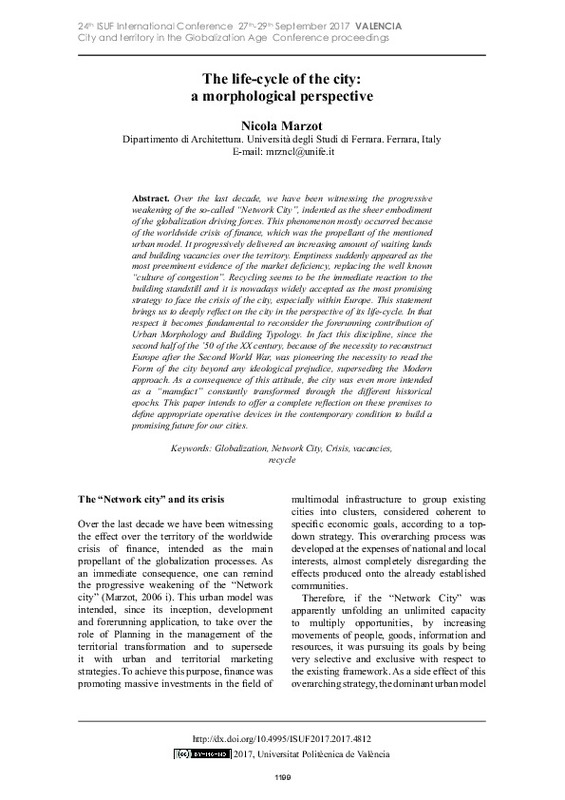JavaScript is disabled for your browser. Some features of this site may not work without it.
Buscar en RiuNet
Listar
Mi cuenta
Estadísticas
Ayuda RiuNet
Admin. UPV
The Cyclicality of the Anthropic Space in Urban Morphology: an architectural perspective
Mostrar el registro sencillo del ítem
Ficheros en el ítem
| dc.contributor.author | Marzot, Nicola
|
es_ES |
| dc.date.accessioned | 2018-12-04T07:36:53Z | |
| dc.date.available | 2018-12-04T07:36:53Z | |
| dc.date.issued | 2018-04-20 | |
| dc.identifier.isbn | 9788490485743 | |
| dc.identifier.uri | http://hdl.handle.net/10251/113443 | |
| dc.description.abstract | [EN] Over the last decade, we have been witnessing the progressive weakening of the so-called “Network City”, indented as the sheer embodiment of the globalization driving forces. This phenomenon mostly occurred because of the worldwide crisis of finance, which was the propellant of the mentioned urban model. It progressively delivered an increasing amount of waiting lands and building vacancies over the territory. Emptiness suddenly appeared as themost preeminent evidence of the market deficiency, replacing the well known “culture of congestion”. Recycling seems to be the immediate reaction to the building standstill and it is nowadays widely accepted as the most promising strategy to face the crisis of the city, especially within Europe. This statement brings us to deeply reflect on the city in the perspective of its life-cycle. In that respect it becomes fundamental to reconsider the forerunning contribution of Urban Morphology and Building Typology. In fact this discipline, since the second half of the ’50 of the XX century, because of the necessity to reconstruct Europe after the Second World War, was pioneering the necessity to read the Form of the city beyond any ideological prejudice, superseding the Modern approach. As a consequence of this attitude, the city was even more intended as a “manufact” constantly transformed through the different historical epochs. This paper intends to offer a complete reflection on these premises to define appropiate operative devices in the contemporary condition to build a promising future for our cities. | es_ES |
| dc.format.extent | 12 | es_ES |
| dc.language | Inglés | es_ES |
| dc.publisher | Editorial Universitat Politècnica de València | es_ES |
| dc.relation.ispartof | 24th ISUF International Conference. Book of Papers | es_ES |
| dc.rights | Reconocimiento - No comercial - Sin obra derivada (by-nc-nd) | es_ES |
| dc.subject | Globalization | es_ES |
| dc.subject | Network city | es_ES |
| dc.subject | Crisis | es_ES |
| dc.subject | Vacancies | es_ES |
| dc.subject | Recycle | es_ES |
| dc.title | The Cyclicality of the Anthropic Space in Urban Morphology: an architectural perspective | es_ES |
| dc.type | Capítulo de libro | es_ES |
| dc.type | Comunicación en congreso | es_ES |
| dc.identifier.doi | 10.4995/ISUF2017.2017.4812 | |
| dc.rights.accessRights | Abierto | es_ES |
| dc.description.bibliographicCitation | Marzot, N. (2018). The Cyclicality of the Anthropic Space in Urban Morphology: an architectural perspective. En 24th ISUF International Conference. Book of Papers. Editorial Universitat Politècnica de València. 1199-1210. https://doi.org/10.4995/ISUF2017.2017.4812 | es_ES |
| dc.description.accrualMethod | OCS | es_ES |
| dc.relation.conferencename | 24th ISUF 2017 - City and Territory in the Globalization Age | es_ES |
| dc.relation.conferencedate | Septiembre 27-29,2017 | es_ES |
| dc.relation.conferenceplace | Valencia, Spain | es_ES |
| dc.relation.publisherversion | http://ocs.editorial.upv.es/index.php/ISUF/ISUF2017/paper/view/4812 | es_ES |
| dc.description.upvformatpinicio | 1199 | es_ES |
| dc.description.upvformatpfin | 1210 | es_ES |
| dc.type.version | info:eu-repo/semantics/publishedVersion | es_ES |
| dc.relation.pasarela | OCS\4812 | es_ES |








